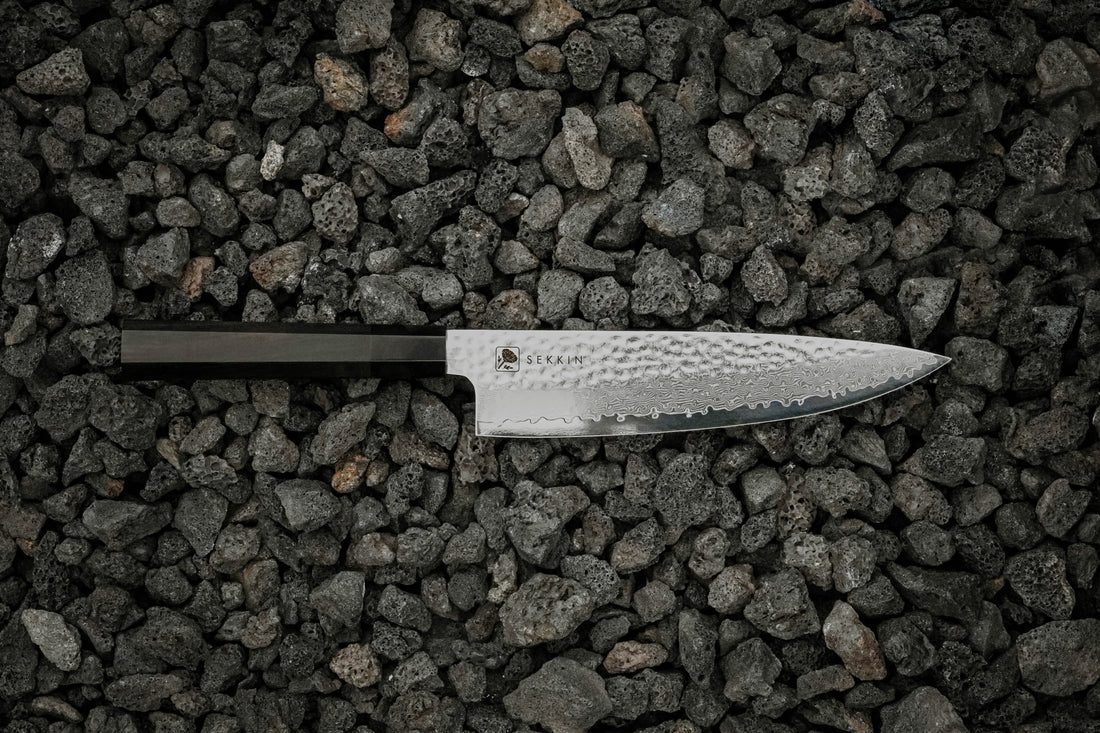
The Essential Guide to Choosing a Chef's Knife
Share
What Exactly is a Chef's Knife?
A chef's knife is the most versatile and essential tool in any kitchen, if you ask us. It typically features a broad, sharp blade that ranges from 6 to 12 inches in length. Designed for a variety of tasks, a chef's knife has a curved edge that helps you chop, dice and mince efficiently. The pointed tip is perfect for precision tasks like slicing herbs or trimming meat.
Take, for instance, the SEKKIN Chef's Knife: an affordable, high-quality Japanese-style chef's knife that transcends ordinary cutlery. With an 8.3-inch blade crafted from 67 layers of Japanese Damascus and AUS10 steels, it embodies the pinnacle of design and functionality.
Can a Chef's Knife Do It All?
Yes, it can! A chef's knife is truly a jack-of-all-trades in the kitchen. Whether you're cutting vegetables, slicing meat or even crushing garlic, this knife is built to handle a wide array of tasks. Its versatility makes it indispensable in both professional kitchens and home kitchens.
The SEKKIN Chef's Knife is a perfect example of this versatility. Engineered with precision, power and finesse, it allows you to effortlessly slice, dice and chop with great ease. Its 16° double beveled edge ensures razor-sharp performance.
What Should You Look for in a Great Chef's Knife?
When shopping for a high-quality chef's knife, there are four important factors to consider:
Blade Material
Look for knives made from high-carbon stainless steel. This material offers a good balance of sharpness and durability, resists rust and keeps its edge for a long time. The SEKKIN Chef's Knife excels here with its 67 layers of Japanese Damascus and AUS10 steels, ensuring exceptional sharpness and longevity.
Handle Comfort
The handle should feel comfortable and secure in your hand. Whether it's made of wood, plastic or composite, it should provide a good grip. Ultimately, the best handle material is a personal preference. The SEKKIN knife features a Pakkawood handle with a water buffalo horn bolster, offering a perfect blend of comfort and elegance.
Balance and Weight
A well-balanced knife, where the weight is evenly distributed between the blade and the handle, provides better control and reduces fatigue. It should feel right in your hand—not too heavy or too light. The SEKKIN knife's half tang design ensures optimal lightweightness and balance, making it an extension of your hand in the kitchen.
Blade Sharpness and Edge Retention
A high-quality chef's knife should be razor-sharp right out of the box and maintain its sharp edge over time. A sharp blade makes cutting easier and more precise. With its 16° double beveled edge and a hardness of 60-62 HRC, the SEKKIN knife promises long-lasting sharpness that professionals and home cooks alike can rely on.
Why Invest in a Quality Chef's Knife?
Investing in a good chef's knife can really elevate your cooking game. A quality knife saves you time and effort, making food preparation more enjoyable and efficient. Plus, a well-made chef's knife can last for years, becoming a reliable partner in your kitchen adventures. By considering these features, you can find a chef's knife that will serve you well for a long time.
Experience the blend of tradition and innovation with the SEKKIN Chef's Knife, and bring the joy of effortless cooking into your kitchen.
Introducing the SEKKIN Chef's Knife
The SEKKIN Chef's Knife is an affordable, high-quality Japanese-style chef's knife that transcends the boundaries of ordinary cutlery. Inspired by Japanese mastery and engineered with precision, power and finesse, this knife empowers you to effortlessly slice, dice and chop with unparalleled ease.
With accolades from renowned experts in the culinary world, the SEKKIN Chef's Knife has earned its reputation as an indispensable tool for professionals and passionate home cooks alike. Indulge in the artistry of culinary perfection with the SEKKIN Chef's Knife and experience the true joy of cooking.
